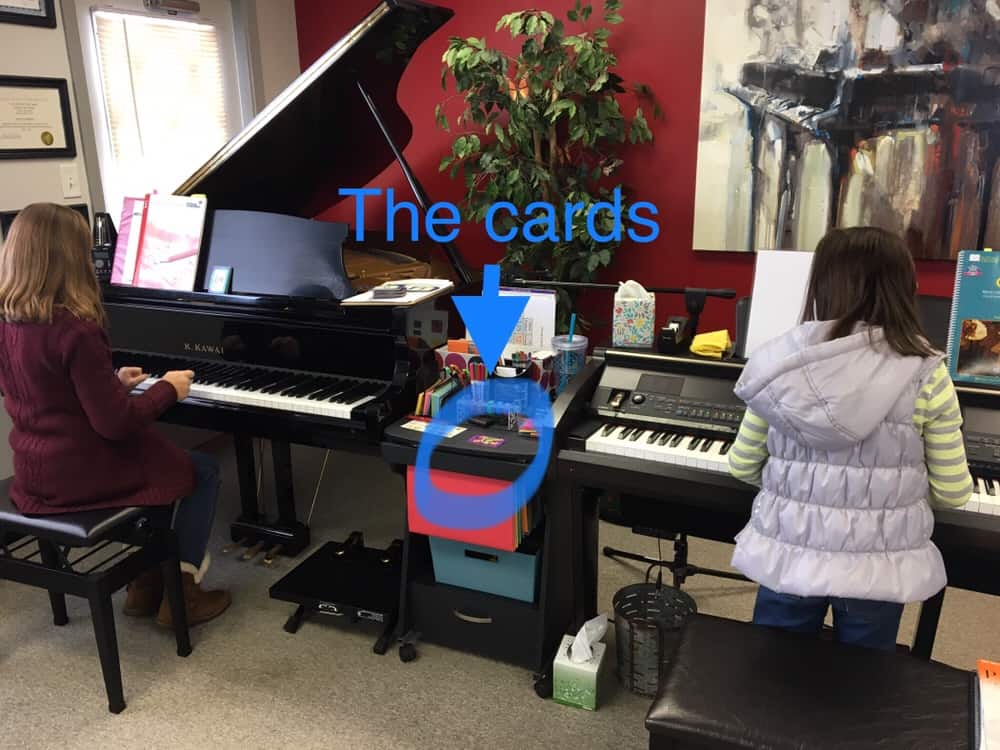Don’t you just love it when you come up with an activity or game that turns out to be a real winner, making you wish you had thought of it sooner? I had one of those moments recently when reviewing major chords and 5-finger patterns and wanted to share the activity with you.
I was looking for a fun way to review all the 5-finger patterns and chords in one sitting in preparation for a festival in which a few students will participate.

The only game I really have for that concept is one of my favorite TCW card games (that’s Three Cranky Women if you’re not familiar with it) – Flashy Fingers.
Most of the TCW card games, though, are not made for students just learning or even in the early-mid stages of mastering any particular concepts. They really have to know their stuff to play most of the games. I’ve tried a lot of their games with students who didn’t know the information like the back of their hand, and it makes the game a lot harder and not nearly as much fun if they have to sit there for a minute to figure out the answer.
Don’t get me wrong; they are high-quality, wonderful games (I own every card deck in the series); they’re just more helpful once the student really knows what they’re doing. The games really help students learn to think faster about concepts they already know and understand well.
Just because particular games are made to be played one way doesn’t mean we can’t utilize them in another, so that’s what I did!
The game is meant to cover major five-finger patterns and chords, so that’s what I focused on in this activity. There were a few parts of the deck that you could use for major or minor (I indicated these with an * below), but it was mostly a review of major patterns.
I’ll show you all the types of cards included in the deck (which make it such a gem) and explain how we played. I even have a really short video clip at the end!

The Card Deck
There are essentially 10 different types of cards in the deck. You could use as many or as few as you wanted at any given time. You could even utilize these cars when initially teaching the concept of 5-finger patterns and chords.
Major 5-finger patterns
(1) Keyboard picture

(2) Letter names of pattern

(3) On staff notes – treble clef

(4) On staff notes – bass clef

(5) Look of black/white keys pattern (*)

(6) Hand displaying which fingers play black keys and the W-W-H-W pattern

Major I Chords
(1) Keyboard picture

(2) Letter names of chord

(3) On staff chord – treble clef

(4) On staff chord – bass clef

(5) Look of black/white key pattern (*)

(6) Chord name (*)

Our Game
I played this game with two sisters – each had their own keyboard. The draw pile was placed between them. They had to grab a card, find and play it on the piano, and say the name of the pattern/chord out loud.

The goal was to obtain the most cards in 10 minutes. Of course, you could do it in a shorter time, but it was our last lesson of the semester, and I planned on spending 20 minutes of their 60 minutes together on a game.
There are a lot of cards, and I wanted to go through them all, so it pretty much took the whole 10 minutes to get through all the 5-finger patterns and another 10 to get through the Major I Chords.
Here were the more specific rules:
- They had to play, not just name the pattern/chord.
- They had to play it hands together (even if it was a card written on the bass clef – they had to use both hands).
- They had to play it broken and then blocked.
- They had to say the name of the pattern/chord, including the quality (i.e., Eb “Major”).
- For the #5 pattern and #5 and #6 chord cards, they could name a minor one.
- Whoever had the most at the end of time got $10 music money (I use the TCW music money as my ongoing incentive program)

The order of the cards I showed you is the order in which I presented the cards. I only set out one group at a time in the order I wanted to present them. You could also mix them up.
I felt like giving them the keyboard picture, and then the exact letter names on the staff helped get them going and worked them up to be able to think faster by the time they got to the open-ended cards.
The more they did, the faster they went, so I would encourage you to let them work through as many as time allows. I stood between them as I had to give them a nod whether or not they executed it correctly before they could grab the next card.
I should mention as a side note that TCW approaches chord patterns as either “Snowmen” (C, F, G), “Hamburgers” (D, E, A), “Ice Cream Sandwiches” (Db, Eb, Ab), or “Odd-Balls” (Bb, Gb, B). A fun way to think about the “look” of chords!
TCW Resources is produced by Kjos. You can buy all their games and theory books on Sheetmusic Plus or any music dealer. You can also follow Three Cranky Women on Facebook and on YouTube where they have video clips of a lot of the games being played.

What’s your favorite TCW game?
What a great way to repurpose a fun game. I love all of TCW games. Thanks for sharing Amy! 🙂
looks like fun , Amy!